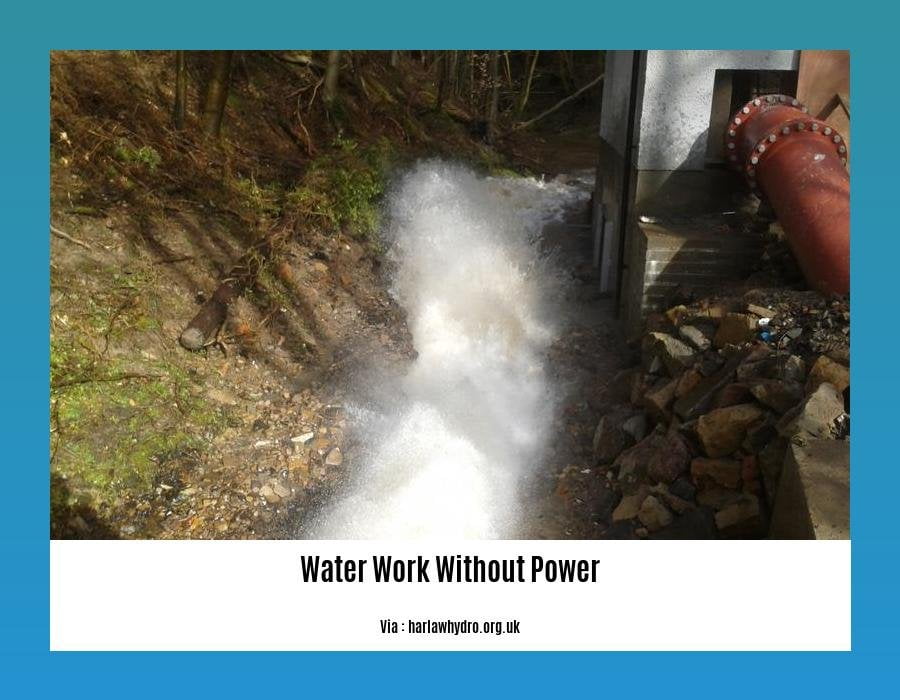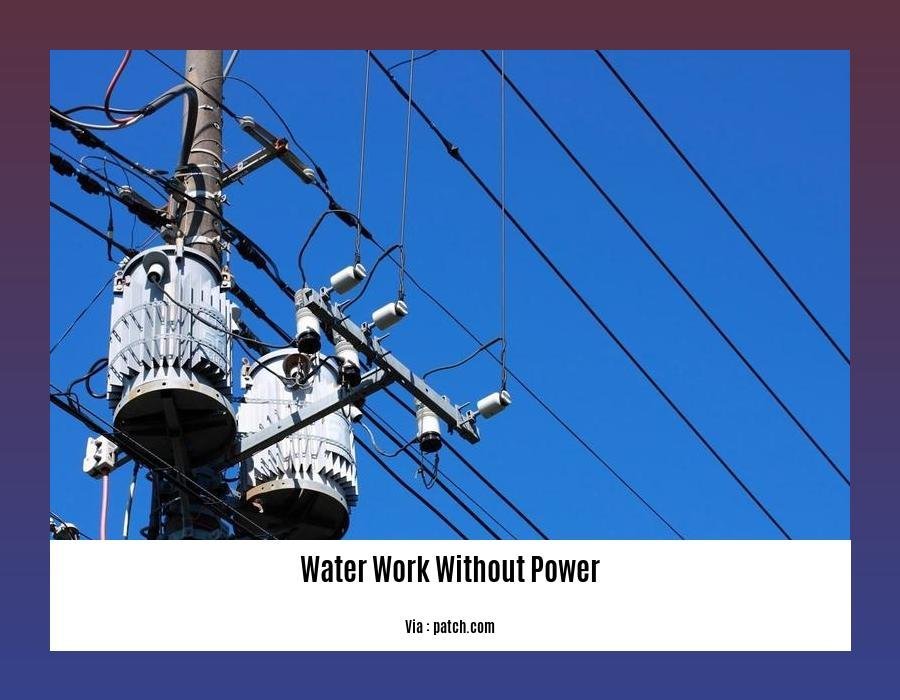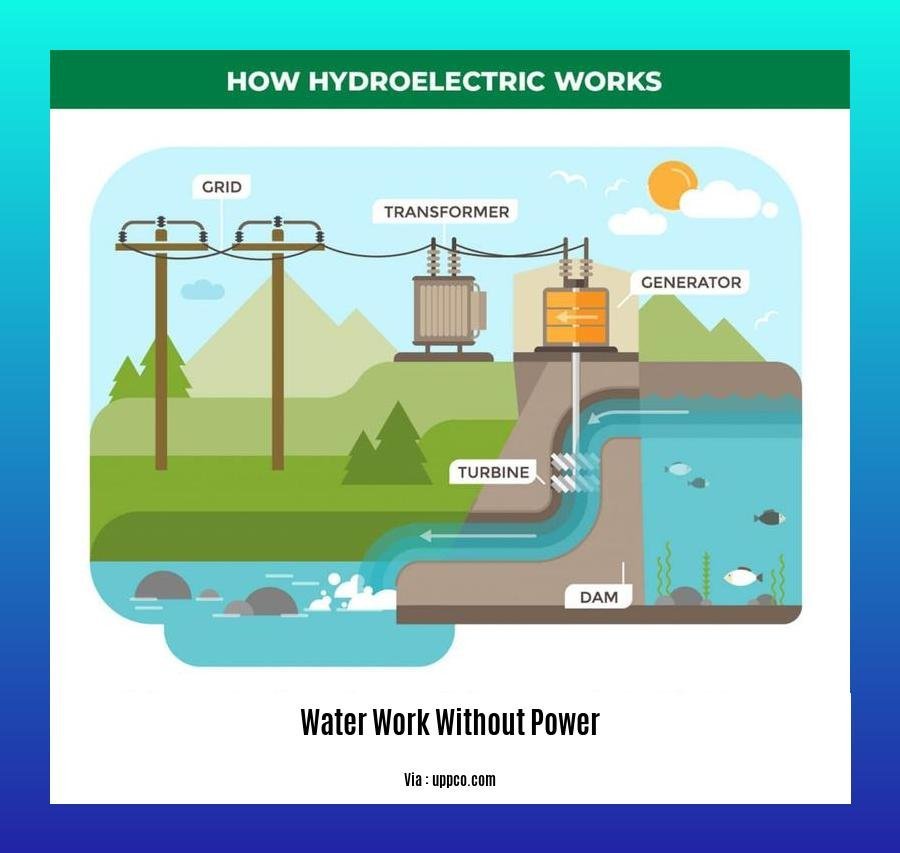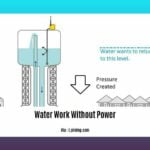Understanding Water Systems: How Does Water Work Without Power?
When we turn on the faucet or step into the shower, we often take for granted the simple act of accessing clean water. Yet, behind the scenes, a complex system of infrastructure and processes work tirelessly to ensure that water reaches our homes and communities. One vital question arises in moments of power outages or natural disasters: How does water continue to flow without the reliance on electricity? In this article, we will delve into the fascinating functionality of water systems without power, exploring the resilience and innovative strategies that enable us to maintain access to this essential resource.
Key Takeaways:
- In a home with city water, the water will continue to work until the water tower is empty or backup generators are activated.
- Users with a private well pump will not have water without a portable generator.
- Apartment buildings or high-rise buildings will experience an immediate loss of water after a power outage due to the dependence on electricity for the water pumping system.
- Plumbing appliances that rely solely on electricity will not function during a power outage.
- Gas-powered water heaters will still work and heat water during a power outage as they are not connected to the electric system.
Does Water Work Without Power?

Water is an essential resource for our daily lives, but what happens when the power goes out? Can water still flow from our taps and showers, providing us with the necessary hydration and sanitation we need? In this article, we will delve into the functionality of water systems without power and explore the different scenarios that can unfold depending on the type of water system and your location.
City Water Systems: A Lifeline during Power Outages
If you reside in an area with access to city water, you can take solace in knowing that water should continue to flow during a power outage. The water supply relies on a combination of gravity and water towers, which act as large storage containers, ensuring a constant flow of water to our homes. Even without electricity, the force of gravity allows water to move through the distribution pipes and into our taps.
However, it’s important to bear in mind that the availability of water during a power outage is not infinite. Eventually, the water tower will empty, and that’s when things can change. Some cities have backup generators in place to ensure a continuous water supply even during emergencies, while others may rely on temporary solutions such as mobile generators or diesel-powered pumps. The duration and reliability of these backup systems may vary depending on the location and resources available to the city.
To find out more specific information about your city’s water system and its resilience during power outages, I highly recommend referencing local authorities or contacting your water utility provider. They will be able to provide you with accurate and up-to-date information.
Private Well Pumps: A Dependence on Generators
For those who rely on private well pumps for their water supply, the situation is a bit different. Private well pumps require electricity to function, meaning that without power, the water will not flow. In such cases, having a portable generator can be a lifesaver, allowing you to power your well pump and maintain access to water. It’s important to ensure your generator is properly maintained and ready for use during emergencies.
Apartment Buildings and High-Rise Structures: A Powerless Predicament
Living in an apartment or high-rise building presents unique challenges when it comes to accessing water during a power outage. Often located in the basement, the water pumping systems that supply water to multiple floors rely on electricity to function. As a result, once the power goes out, the water supply will stop immediately, leaving residents without running water.
For tenants in such buildings, it’s crucial to have a contingency plan in place. Stocking up on bottled water, having a personal emergency water supply, and following guidance from building management or emergency services can help mitigate the impact of a water shortage during a power outage.
Plumbing Appliances: A Matter of Electricity vs. Gas
When it comes to plumbing appliances, the availability of water without power can also vary depending on the specific appliance and its reliance on electricity. Anything that exclusively relies on electricity, such as electric water heaters or electric-powered showers, will not work during a power outage.
On the other hand, gas-powered water heaters present a different scenario. As gas is not connected to the electrical system, gas-powered water heaters can continue to function and heat water even without power. This can provide a source of warm water for essential tasks such as washing dishes or maintaining personal hygiene.
Conclusion
In summary, whether water works without power depends on various factors such as the type of water system and your location. City water systems generally have contingency plans in place to ensure water availability during power outages, at least until the water tower is empty or backup generators are activated.
For individuals with private well pumps, the water will not work without a generator to provide the necessary electricity. Apartment buildings and high-rise structures face immediate water shortages as the water pumping systems rely on electricity to function.
Understanding the limitations of your specific water system and having contingency plans in place can help ensure you are prepared and resilient during power outages and other emergencies. Remember to consult local authorities and water utility providers for accurate and comprehensive information relevant to your area.
Now that you have a better understanding of how water systems can function without power, you can take steps to ensure your water supply remains available during unexpected emergencies. Stay informed, stay prepared, and stay hydrated!
If you’re wondering how a power outage affects your water heater, click here to find out more.
Curious if your water heater can function without electricity? Discover the answer by clicking here.
Intrigued about whether well water works during a power outage? Click here to learn more.
Alternative Methods for Accessing and Distributing Water During Power Outages
Alternative methods for accessing and distributing water during power outages are crucial for ensuring a continuous water supply, especially in emergency situations. When traditional power sources fail, it is important to have backup options in place to maintain access to this essential resource. In this article, we will explore various alternative methods that can be used to access and distribute water without relying on electricity.
Solar Pumps: Harnessing the Power of the Sun
One alternative method for accessing water during a power outage is through the use of solar pumps. These pumps utilize solar energy to draw water from wells, providing a reliable and sustainable solution. By converting sunlight into electrical energy, solar pumps can effectively operate without the need for traditional power sources. Organizations like Savvy Survivor recommend using solar pumps as a viable option for accessing well water without electricity (source: savvysurvivor.com).
Wind-Powered Pumps: Utilizing Nature’s Energy
Another method that can be employed to access well water during power outages is the use of wind-powered pumps. As the name suggests, these pumps harness the energy of the wind to draw water from wells. Outdoor Life suggests wind-powered pumps as an alternative method for accessing well water without electricity (source: outdoorlife.com). By utilizing renewable wind energy, these pumps can provide a sustainable solution for obtaining water when traditional power sources are unavailable.
Hand Pumps: Old-School Reliability
Hand pumps are a reliable and time-tested method for accessing water from shallow wells without electricity. These manually operated pumps enable individuals to draw water from wells using their own physical strength. Primal Survivor recommends hand pumps as an effective alternative for accessing water when power is unavailable (source: primalsurvivor.net). Their simplicity and reliability make them a valuable asset during power outages or in remote areas where electricity may not be accessible.
Generators: Backup Power Sources for Deep Wells
In cases where deep well pumps are in use, generators can serve as backup power sources during outages. Portable generators can provide the necessary electrical power to keep deep well pumps operational until the main power supply is restored. It is important to know the power requirements of your well pump before attempting to generate your own power during a power outage (source: outdoorlife.com). By having a generator on hand, a continuous water supply can be ensured even when traditional power sources fail.
Portable Generators for Water Utilities
Smaller water utilities can leverage portable generators to rotate backup power between lift and pump stations during a blackout. The Environmental Protection Agency (EPA) highlights the use of portable generators as a means of maintaining water flow and distribution systems during power outages (source: epa.gov). By strategically deploying these generators, water utilities can mitigate the impact of power failures, ensuring reliable access to water for their customers.
Manual Extraction Methods: Back to Basics
In situations where modern infrastructure is absent, manual extraction methods can be employed to pump water from hand-dug wells without electricity. These methods include using a well-bucket-and-rope system or a hand pump. Drinking Water Org suggests using manual extraction methods as a way to access water when power is not available (source: drinking-water.org). While these methods may require more physical effort, they can provide a critical water source during emergencies or in areas with limited access to electricity.
Key Takeaways:
- Solar pumps and wind-powered pumps offer sustainable alternatives for accessing well water during power outages.
- Hand pumps provide a reliable method for accessing water from shallow wells without electricity.
- Generators can serve as backup power sources for deep well pumps, ensuring continuous water supply during outages.
- Portable generators can be utilized by smaller water utilities to maintain water flow and distribution systems during blackouts.
- Manual extraction methods, such as well-bucket-and-rope systems or hand pumps, can be used when traditional power sources are unavailable.
Sources:
– Savvy Survivor: savvysurvivor.com
– Outdoor Life: outdoorlife.com
Case Studies of Communities That Have Successfully Maintained Water Supply Without Power

In today’s modern world, a reliable water supply is often taken for granted. We turn on the tap, and clean, safe water flows effortlessly into our homes. But what happens when the power goes out? How does water work without electricity? In this article, we will explore case studies of communities that have successfully maintained their water supply even in the absence of power.
The Resilience of Community-Based Water Supply Projects
Community-based water supply projects (CBWS) play a crucial role in ensuring sustained access to clean water, especially in developing countries. However, these projects face challenges in terms of sustainability and effectiveness. Lack of community participation, limited resources, and inadequate knowledge often hinder the success of such initiatives.
Research studies have emphasized the importance of community engagement and institutional support in improving water supply management. It has been observed that when communities actively participate in the planning, implementation, and management of water systems, their resilience during power outages significantly improves.
Case Study: Water Supply and Sanitation for Low-Income Communities in Indonesia
The World Bank has documented a case study on water supply and sanitation for low-income communities in Indonesia. This study highlights the success of an initiative that aimed to provide sustainable water supply to urban areas where access was limited. The project utilized community participation and capacity building to ensure the long-term functionality of the water systems.
Key Takeaways:
- Community participation is crucial for the effectiveness and sustainability of urban water supply and sanitation systems.
- Studies have shown that the success of community participation relies on satisfying participatory elements such as capacity building and knowledge.
- Lack of understanding of the holistic nature of sustainability issues is a major challenge in achieving sustainable water supply systems in communities.
- Objective case studies of successful urban water management systems in developing countries are limited.
(Source: World Bank)
The Effectiveness of Community Participation in Urban Water Supply
Another research study evaluated the effectiveness of community participation in urban water supply. The study assessed various factors influencing the success of community-managed water supply projects, such as governance, finance, and community involvement. It emphasized the need for developing sustainable mechanisms to encourage greater community participation and decision-making processes.
Key Takeaways:
- Community-based water supply projects (CBWS) need to be assessed for their sustainability in terms of environmental, economic, and social factors.
- Community knowledge and institutional support play a crucial role in improving water supply management.
- ResearchGate provides resources on the effectiveness of community participation in urban water supply and the review of community-managed water supply.
(Source: ResearchGate)
Objective Case Studies of Successful Urban Water Management
In an effort to provide comprehensive insights into successful urban water management, a study focused on objective case studies of urban water supplies. It highlighted the example of Phnom Penh Water Supply Authority (PPWSA) in Cambodia and its sustainable water supply system. The case study emphasized the importance of efficient infrastructure, institutional reforms, and community involvement in achieving sustainable water supply.
Key Takeaways:
- The World Bank has documented a case study on water supply and sanitation for low-income communities in Indonesia.
- Taylor & Francis Online offers an article on objective case studies of successful urban water management, focusing on the example of PPWSA in Cambodia.
(Source: Taylor & Francis Online)
Conclusion
Water systems can still function without power, thanks to the resilience and innovative strategies employed by communities worldwide. Through community participation, capacity building, and institutional support, water supply can be sustained even during power outages. Case studies like those explored in this article provide valuable insights into successful approaches to maintaining water supply without relying on electricity.
Remember, understanding the holistic nature of sustainability in water systems and implementing contingency plans are vital for communities to navigate through emergencies and ensure access to clean water.
Key Takeaways:
– Community participation is crucial for the effectiveness and sustainability of urban water supply and sanitation systems.
– Studies have shown that the success of community participation relies on satisfying participatory elements such as capacity building and knowledge.
– Lack of understanding of the holistic nature of sustainability issues is a major challenge in achieving sustainable water supply systems in communities.
– Objective case studies of successful urban water management systems in developing countries are limited.
– Community-based water supply projects (CBWS) need to be assessed for their sustainability in terms of environmental, economic, and social factors.
– Community knowledge and institutional support play a crucial role in improving water supply management.
– The World Bank has documented a case study on water supply and sanitation for low-income communities in Indonesia.
– ResearchGate provides resources on the effectiveness of community participation in urban water supply and the review of community-managed water supply.
– Taylor & Francis Online offers an article on objective case studies of successful urban water management, focusing on the example of PPWSA in Cambodia.
(Source: World Bank, ResearchGate, Taylor & Francis Online)
Innovative Strategies and Technologies to Ensure Access to Clean Water During Emergencies
Emergencies and disasters can disrupt power supply, leading to potential water shortages. However, innovative strategies and technologies have been developed to ensure access to clean water even during these challenging times. In this article, we will explore some of these solutions and their effectiveness in addressing water-related emergencies.
Water Storage and Conservation:
Ensuring a stable water supply during emergencies starts with efficient water storage and conservation practices. Water tanks and reservoirs can be strategically placed to store sufficient water for communities. Additionally, individuals can play their part by storing water in bathtubs, buckets, or any available containers once they hear about an impending power outage or disaster. These existing water sources can provide a short-term solution until other methods are implemented.
Rainwater Harvesting:
Utilizing rainwater as an alternative water source is an innovative strategy that can be effective during emergencies. Rainwater can be collected and stored in tanks or barrels for future use. With the help of gutter systems attached to buildings, rainwater can be channeled into storage containers easily. This method not only conserves water but also reduces reliance on electricity-dependent sources.
Portable Water Filtration Systems:
Innovative strategies and technologies to ensure access to clean water during emergencies include the use of portable water filtration systems. These compact devices are designed to remove impurities and contaminants from untreated water, making it safe for consumption. Whether it’s a hand-held filter or a larger portable unit, these systems offer a reliable solution for emergency situations where access to clean water is limited.
Emergency Water Treatment Units:
In the event of a major disaster, innovative strategies and technologies such as emergency water treatment units can be deployed. These self-contained systems are capable of purifying large volumes of water, making it suitable for drinking and other essential uses. These units are often equipped with multiple stages of filtration, disinfection, and chemical treatment processes to ensure the removal of harmful substances.
Solar-Powered Water Pumps:
Harnessing the power of the sun, solar-powered water pumps are excellent options for providing water supply during emergencies. These pumps utilize solar energy to extract water from wells or other sources. The energy from the sun is converted into electricity, eliminating the need for grid power. With the right setup, solar-powered water pumps can reliably supply water even in locations with no access to electricity.
Community Engagement and Education:
One of the most essential elements to ensuring access to clean water during emergencies is community engagement and education. By raising awareness and providing individuals with the knowledge and tools to manage water resources efficiently, communities can better prepare themselves for water-related emergencies. Encouraging water-saving practices, promoting rainwater harvesting, and educating individuals on emergency response protocols are crucial steps that empower communities to be self-reliant during challenging times.
Key Takeaways:
- Innovative strategies and technologies play a vital role in ensuring access to clean water during emergencies.
- Water storage and conservation methods are essential for maintaining a stable water supply during power outages or disasters.
- Rainwater harvesting provides an alternative water source and reduces reliance on electricity-dependent systems.
- Portable water filtration systems offer a convenient way to treat water from various sources, making it safe for consumption.
- Emergency water treatment units are capable of purifying large volumes of water, ensuring its safety during emergencies.
- Solar-powered water pumps utilize renewable energy to extract water from wells or other sources, providing a reliable supply during power outages.
- Community engagement and education are crucial for empowering individuals and communities to be prepared and self-reliant during water-related emergencies.
Sources:
1. Nature – The need for present technologies to be available to children growing up without access to clean water sources.
2. World Economic Forum – Sustainable technologies can help tackle the global water crisis.
FAQ
Q1: How does water work in a home with city water during a power outage?
A1: In a home with city water, the water should continue to work until the water tower is empty or the city activates backup generators[^1^].
Q2: What happens to the water supply in an apartment or high-rise building during a power outage?
A2: In an apartment or high-rise building, the water will stop working immediately as the water pump requires electricity[^3^].
Q3: Can I still access well water without electricity?
A3: If you have a private well pump, the water will not work without a generator[^2^]. However, there are alternative methods such as solar pumps, wind-powered pumps, and hand pumps that can be used to access well water without electricity[^2^][^3^].
Q4: Will a gas-powered water heater still provide hot water during a power outage?
A4: Yes, if you have a gas-powered water heater, the water will still be heated even without power[^4^].
Q5: How can water utilities ensure access to clean water during a power outage?
A5: Water utilities can use portable generators to rotate backup power between lift and pump stations during a blackout, ensuring continuous water supply[^7^]. Additionally, manual extraction methods like well-bucket-and-rope systems or hand pumps can be used to pump water from hand-dug wells without electricity[^8^].
- Discover Long Black Pepper: Flavor & Health Benefits - April 25, 2025
- Shocking Twists: The Grownup Review: Unreliable Narration - April 25, 2025
- A Quiet Place Book vs Movie: A Deep Dive - April 25, 2025
















